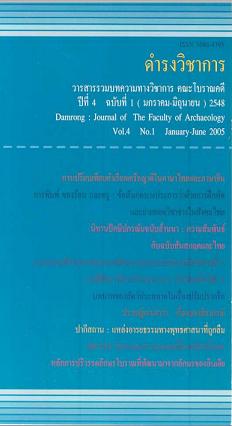Transliteration principle of the ancient scripts derived from India
Keywords:
อักษรโบราณ, อักษรอินเดีย, การปริวรรตAbstract
Phe Ta Khon of Dansai, Loei, is a play; a part of Boon Phraves ceremonies in which performers were awful head-masks that resemble ghosts. Some theories indicate that it evolved from archaic rituals relating to Phra Tam cave paintings and was connected to ‘Phou Yeuo Ya Yeuo’ of Laos-Lung Prabang belief. Nowadays, social contexts have changed causing the form and meaning of Phe Ta Khon to adapt. Finally, it is now deemed as a festival for tourism and the traditional meaning has been deserted.
References
หนังสือและวารสาร
กรมศิลปากร. จารึกในประเทศไทย เล่ม 1. กรุงเทพฯ : โรงพิพม์ภาพพิมพ์, 2529.
อุไรศรี วรศะริน และ อรวรรณ บุญยฤทธิ์. เอกสารประกอบการอบรมเรื่อง "ระบบการถ่ายถอดอักษรแบบ Transiterations และ Transcriptons." คณะโบราณคดี มหาวิทยาลัยศิลปากร วันที่ 13 พฤษภาคม 2545.
Antelme Michel. "Note on the Transliteration of Khmer." Udaya Journal of Khmer Studies. No. 3, 2002. 1-33.
Coades G. Inscriptions du Cambodge vol. v. Paris : A. Maisonneuve, 1953.
Pou Saveros. Dictionnalre Vleuxkhmer - Frangais - Anglais. Paris : Cedoreck, 1992.
สำเนาจารึก
สำเนาจารึกเขารัง จารึก เย ธมฺมา และ จารึกพระเจ้ามเหนทรวรมัน ของภาควิชาภาษาตะวันออก คณะโบราณคดี มหาวิทยาลัยศิลปากร
สื่ออิเล็กทรอนิกส์
Makato Minegishi and Jun Takashima. Issues in Transllteration for Khmer and Thai Scripts. Accessed 29 April 2004 Availabe from http://semioweb.msh_paris.Fr/escom/project_re
Transliteration principles. Accessed 29 April 2004 Available from http://acharya.itm.ac.in/multi_sys/translit.html
Downloads
Issue
Section
License
บทความนี้เป็นผลงานของข้าพเจ้าแต่เพียงผู้เดียว และ/หรือเป็นผลงานของข้าพเจ้าและผู้ร่วมงาน ตามชื่อที่ระบุในบทความจริง และเป็นผลงานที่มิได้ถูกนำเสนอหรือตีพิมพ์ที่ใดมาก่อน





